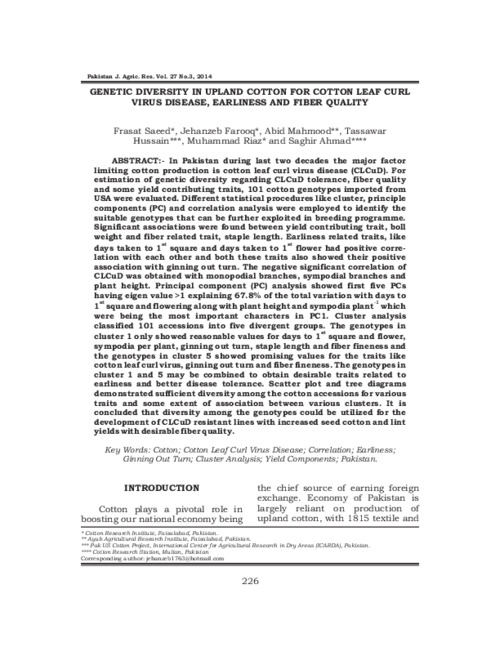Genetic diversity in upland cotton for cotton leaf curl virus disease, earliness and fiber quality
Abstract
In Pakistan during last two decades the major factor
limiting cotton production is cotton leaf curl virus disease (CLCuD). For
estimation of genetic diversity regarding CLCuD tolerance, fiber quality
and some yield contributing traits, 101 cotton genotypes imported from
USA were evaluated. Different statistical procedures like cluster, principle
components (PC) and correlation analysis were employed to identify the
suitable genotypes that can be further exploited in breeding programme.
Significant associations were found between yield contributing trait, boll
weight and fiber related trait, staple length. Earliness related traits, like
st st days taken to 1 square and days taken to 1 flower had positive correlation
with each other and both these traits also showed their positive
association with ginning out turn. The negative significant correlation of
CLCuD was obtained with monopodial branches, sympodial branches and
plant height. Principal component (PC) analysis showed first five PCs
having eigen value >1 explaining 67.8% of the total variation with days to
st -1 1 square and flowering along with plant height and sympodia plant which
were being the most important characters in PC1. Cluster analysis
classified 101 accessions into five divergent groups. The genotypes in
st cluster 1 only showed reasonable values for days to 1 square and flower,
sympodia per plant, ginning out turn, staple length and fiber fineness and
the genotypes in cluster 5 showed promising values for the traits like
cotton leaf curl virus, ginning out turn and fiber fineness. The genotypes in
cluster 1 and 5 may be combined to obtain desirable traits related to
earliness and better disease tolerance. Scatter plot and tree diagrams
demonstrated sufficient diversity among the cotton accessions for various
traits and some extent of association between various clusters. It is
concluded that diversity among the genotypes could be utilized for the
development of CLCuD resistant lines with increased seed cotton and lint
yields with desirable fiber quality

